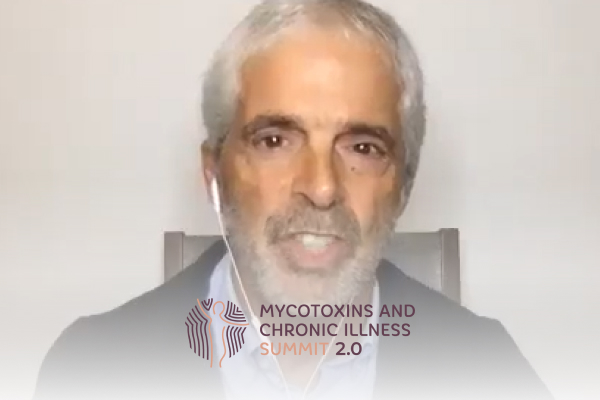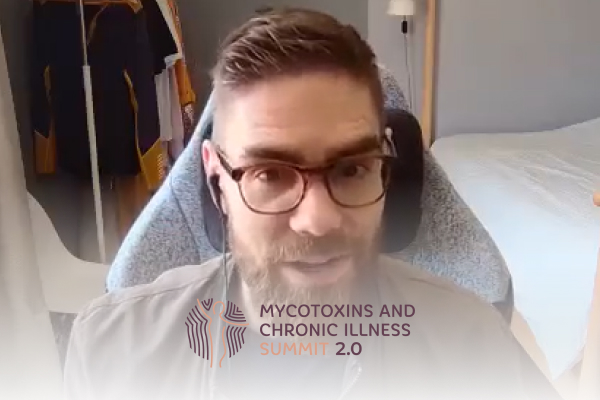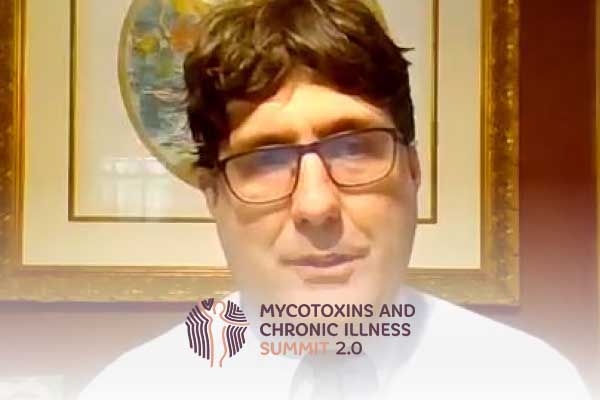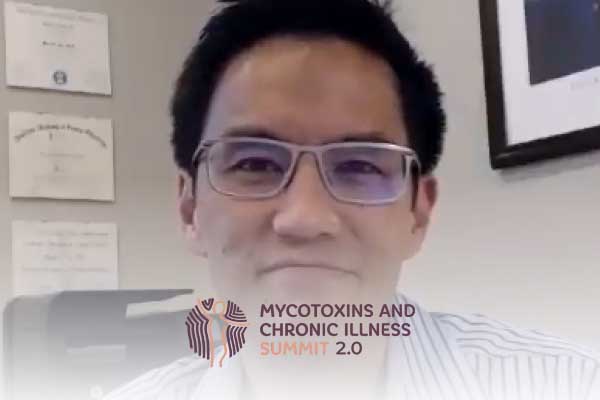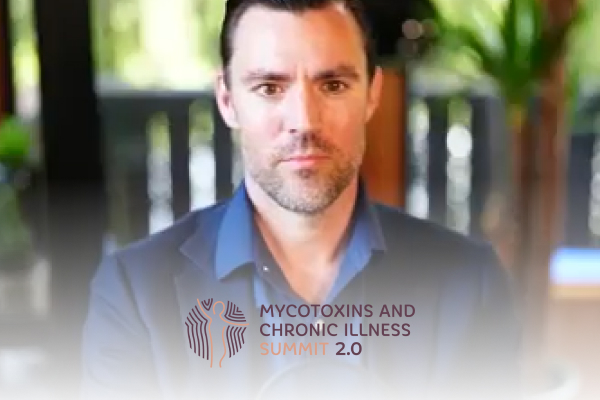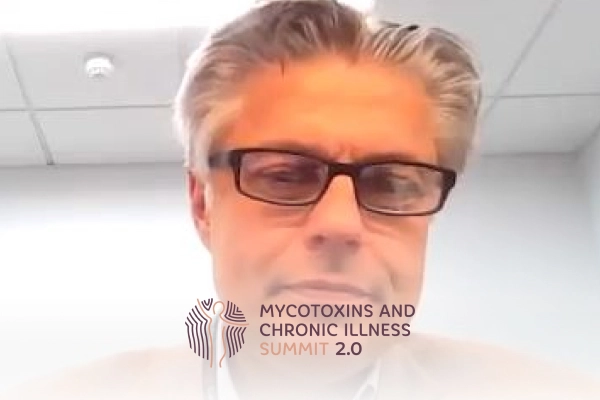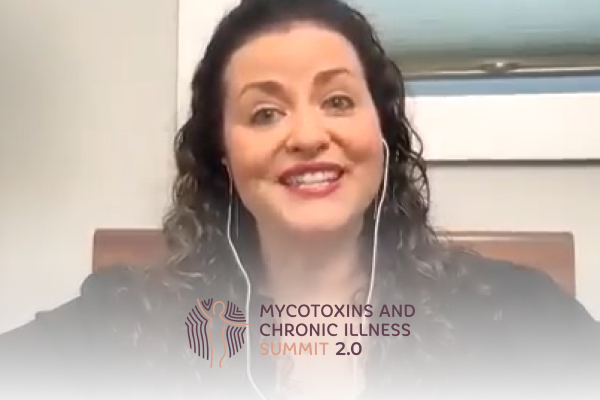Join the discussion below
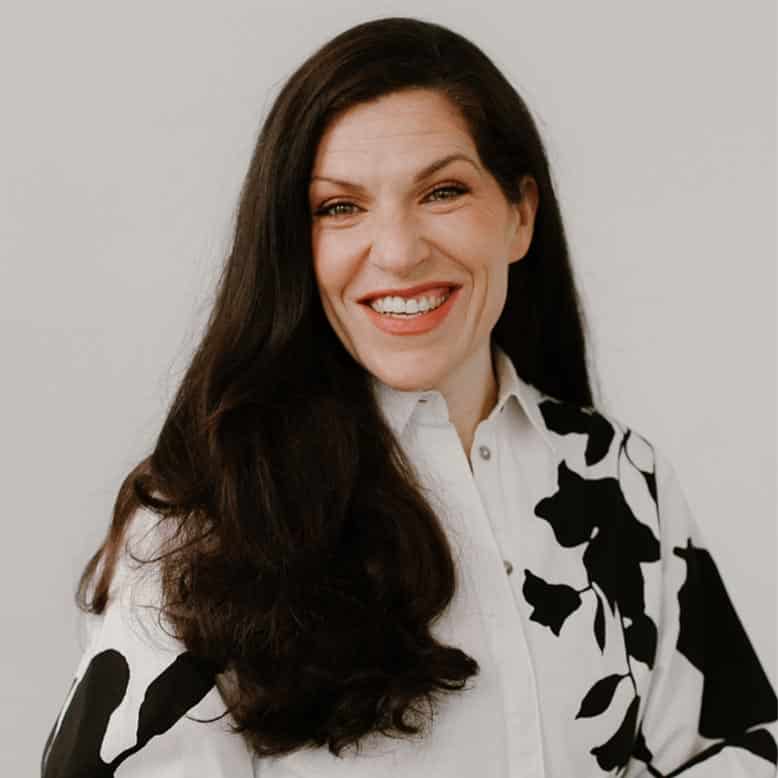
Dr. Christine Schaffner is a board-certified Naturopathic Doctor who has helped thousands of people recover from chronic or complex illnesses. Through online summits, her Spectrum of Health podcast, network of Immanence Health clinics, and renowned online programs, Dr. Schaffner goes beyond biological medicine, pulling from all systems of medicine and... Read More

Tom O’Bryan, DC, CCN, DABCN, CIFM
Dr. O’Bryan is considered a ‘Sherlock Holmes’ for chronic disease and teaches that recognizing and addressing the underlying mechanisms that activate an immune response is the map to the highway toward better health. He holds teaching Faculty positions with the Institute for Functional Medicine and the National University of Health... Read More
- It’s never “just” mold, there are always additional environmental triggers.
- Favorite nutritional solutions to reduce inflammation.
- The extra steps you may need to rebuild your immune system.
Christine Schaffner, N.D.
Welcome everyone to the Mycotoxin and Chronic Illness Summit. I’m Dr. Christine Schaffner, and today my guest is my dear friend and mentor, Dr. Tom O’Bryan, and we’re gonna be picking his brain literally, and looking at where does mold fit in this overview, in this picture of chronic inflammatory diseases that are so rampant today. So welcome Dr. Tom. I’m really honored to get to interview you again.
Tom O’Bryan DC, CCN, DACBN, CIFM
Oh, thank you, and it really is my pleasure, and it’s always a joy to bounce back and forth off each other. We create new lines of thinking for people when we dance together. So it’s a pleasure to be with you.
Christine Schaffner, N.D.
Oh, thank you, I so agree. I so enjoy these interviews and this time together, because I always learn so much and then there’s new insights that come forth, so we’re gonna be, with that intention, sharing a lot of information so that people who are listening to really get on their path to healing. There’s too many people suffering out there and they really need this information. And I thought we could start, and we chatted a bit about zooming out for a minute, and looking at the big picture, and really like, where do you see mold and how that contributes to disease development today?
Tom O’Bryan DC, CCN, DACBN, CIFM
I think that’s very important. And I think, especially for people who are watching this, you have an interest in this subject, and having the interest in this subject, which is critically important, often puts blinders on or restrictions in seeing the bigger picture. So I’d like to start with the bigger picture, and the analogy I’ll give you, if you’re gonna take a flight and you check in at the gate, you board the plane and you’ve got a window seat. You look out the window and you can see the baggage guys throwing the bags up onto the conveyor belt going up in the plane. Oh, I hope they don’t throw my bag like that, and all of that. And you can see the plane at the gate next to you, but you really can’t see much else, maybe a little bit out there, the next gate or something.
As the plane gets pushed away from the gate, now you see, oh, look, there’s seven gates and planes. Wow, there’s a lot of people traveling. I never really thought about how many people are traveling. And so your mind just starts to expand a little bit, more than when you’re sitting at the gate and there’s a plane next to you. Then as you taxi out to the runway, you see the forest on the other side of the runway, all the trees there. And as the plane starts to take off, you say, oh, that’s a forest. That’s not just a row of… Oh, look, there’s a lake there in the middle of the forest. Oh, look, wow, look at the farmland. And you go higher and higher, and there’s the skyline of the city that you’re leaving, until you get to the 30,000-foot view.
And now you’re cruising. And one of the goals I hope to give our viewers today is a 30,000-foot view on mold and its contribution here. And I’m going to start with our mentor and friend, Dr. Alessio Fasano, who is a Professor of Pediatrics at Harvard Medical School, a Professor of Nutrition, Harvard School of Public Health, the Director of Mucosal Immunology. That’s the lining of the lungs, the lining of the gut, the lining of your brain, the mucosa. He’s the Director of that department at Harvard, the Director of the Celiac Research Center at Harvard, and the Chief of Pediatric Gastroenterology, Mass General Hospital, Harvard. Five positions, any one of those positions is a lifelong goal for people at the top of their field. And he’s got five, and we think he’s gonna win the Nobel Prize. We truly do.
Because he and his team are the ones who identified the mechanism of this thing we now call leaky gut, the slang term of leaky gut. They identified it in 1997, and they’ve been publishing hundreds, literally hundreds of papers in the last 25 years about this thing and how it works. So Professor Fasano, obviously one of the experts in the world on these health topics, he’s always so careful of his language so that he’s not misquoted. He wrote a paper in 2020, so just over a year and a half ago, and the title of the paper says it all. And now this guy, one of the best in the world, always really careful about what he says. The title of the paper is “All Disease Begins in the ‘Leaky Gut:’ The Role of the Protein Zonulin,” and that’s the protein that creates the leaky gut. “The Role of the Protein Zonulin in the Development of Chronic Inflammatory Diseases.” All disease begins in the gut, and this is what they’re teaching now at Harvard Medical School.
So our young doctors who will be coming out will be extremely aware of these concepts that only physicians on the cutting edge, like you and other guests on this summit who are willing to look outside the standard box. Now our young docs coming out, this is how they’re coming out with this training, which is so critically important. Professor Fasano talks about the five pillars in the development of chronic inflammatory diseases. Now, why is that important? Because nine of the top 10 causes of death in the US today are chronic inflammatory diseases. Nine of the top 10. The only one that’s not is unintentional injuries, accidents. Everything else is chronic inflammation.
That’s the 30,000-foot view. So when you understand that what’s going to take us down eventually, and hopefully much later than sooner, for the vast majority of people is a chronic inflammatory disease, then the question becomes, how do I reduce the inflammation in my body, and in my family’s body, so that I’m not slowly killing off tissue? And he identified five pillars in the development of chronic inflammatory diseases. And I think it’s really important to understand this. And then it’ll be obvious how mold fits into this. The first is genetics. You can’t do anything about the genes. That’s the deck of cards that you were dealt in life. But how active those genes are is often in your control. There are some genes like cystic fibrosis, if you carry that gene, it’s extremely difficult to not get cystic fibrosis.
There are a few genes like that, but the vast majority of our genes, the breast cancer genes, the Alzheimer’s genes, the celiac genes, the ones that are so very, very common. It doesn’t mean you’re getting the disease. It means if the gene expresses itself, if it’s turned up and turned up, then… You know, you pull at a chain, it always breaks at the weakest link. It’s at one end, the middle, the other end. Your heart, your brain, your liver, your kidneys, wherever your genetic weak link is, that’s where the chain’s gonna break. Your genetics are the weak link in your chain. So the goal is don’t pull so hard on the chain. And that’s inflammation. And I was guilty, and I think many of us were guilty of talking about turning genes off, turning off the Alzheimer’s. You can’t turn genes off.
What you can do, genes operate on a dimmer switch, and you can dim them down or they can ramp up. And what controls that knob on the dimmer switch whether it’s bright or not? What controls that knob, what has its hands on the knob of the dimmer switches of your genes, is number two of the five pillars that Fasano talks about, environmental triggers. So it’s what we’re exposed to, both outside coming in, and what’s already inside that has its hands on the knob that turns up the genes of inflammation, turns down the genes of inflammation, turns up the genes of anti-inflammation, younger, healthier cells, or turns down the genes of anti-inflammation, younger, healthier cells. So environmental triggers, and that’s a big topic. And before we got started, I mentioned to you, and I don’t know if we’ll have time to elaborate on this, I’ll say it now, is that when people have mold problems, I have never had a patient who exclusively just had mold problems. They’ve also got food sensitivities. There might be some other environmental triggers. They’ve got heavy metals, or there’s other environmental triggers pulling on their chain besides the mold. And mold may be critically important and primary to deal with right away so a person can function better, but there’s always more triggers with their hands on how our genes are expressing themselves.
So that’s number two, were the environmental triggers. Number three is that when you have too many environmental triggers, you create this imbalance of the good guys and the bad guys in your gut. And the technical term is dysbiosis, meaning too many bad guys, not enough good guys. That’s critically important because we know 36% of all the small molecules in your bloodstream are the exhaust, I call it the exhaust, of the bacteria in your gut. Now the technical term is the metabolites of the bacteria in your gut, but 36% of everything in your bloodstream, and your bloodstream’s just a highway, lots of traffic on the highway, but it’s just a highway, right? And everything’s going in the same direction.
They bump into each other. Whenever I talk about this, I think of when I was a kid, we’d go to the circus and we’d get the bumper cars. And my brother and I, we’d smash into each other with those bumper cars. That’s what the bloodstream’s like, always, bouncing into each other inside there. But 36% of everything is the exhaust of the bacteria in your gut because they are the messengers telling the brain how to function. We know from Professor Michael Gershon at Princeton, back in 1999, he wrote the book, “The Second Brain,” And he told us back then that for every one message from the brain going down, telling the gut what to do, there are nine messages from the gut, going up, telling the brain what to do. So the balance of your brain hormones, called neurotransmitters, the balance of that is all controlled by the bacteria in your gut. So if you have too many of the bad guys, the message you get is inflammation pulling on the chain, wherever your weak link is, throughout your body.
So that’s number three, is the dysbiosis, or the imbalance that occurs. Number one, genetics. Number two, environmental triggers. Number three, dysbiosis, creating that inflamed gut, which then creates number four, the leaky gut. Now Mrs. Patient, your gut is a tube from the mouth down to the other end, one big long tube that winds around in there. It’s lined with cheesecloth. And when we eat food, you swallow a piece of hamburger. You chew a few times. We all should chew more. We’ve all heard that, but we don’t. but you take three chomps, dum, dum, dum, and you swallow. And that piece of meat can’t get into your bloodstream. It’s gotta be broken down, called digestion, into smaller pieces, smaller pieces, smaller pieces, tiny, tiny little pieces until it gets down to what are called amino acids.
And those go right through the cheesecloth into the bloodstream. So that big clump can’t get into the bloodstream. It’s gotta be broken down really small. But when you get the leaky gut, you get these bigger molecules of whatever you’ve eaten that go through the tears in the cheesecloth. That’s the leaky gut. The inflammation causes tears in the cheesecloth. Now, whatever you eat, molecules that are getting through into the bloodstream before there’s been enough time for them to be chopped up small enough, they’re called macro molecules, big molecules, and your immune system, trying to protect you, says, what is that in the bloodstream? I better fight that. Now you make antibodies to fight whatever that is, and that’s in the bloodstream, now you’ve got systemic inflammation, ’cause it’s in the bloodstream. The bloodstream goes everywhere.
So you’ve got this systemic, all over your body, inflammation pulling on the chain, pulling on the chain, pulling on the chain. And the result is, wherever your genetic weak link is, that’s where the chain’s gonna break. That’s the symptoms you get. This is what they’re teaching at Harvard Medical School, much more complicated, and really in a lot of detail, but this is the big kahuna concept. This is a 30,000-foot view. So when we wanna be healthier, all disease begins in the gut. So we always want to include addressing the gut, making sure you have a healthy, diverse microbiome of the good bacteria in your gut. Always focusing this much attention every day for the rest of your life on a healthy, diverse microbiome for you and your family. Critically important. When you’re dealing with chronic mold infections, you gotta take a load off of the immune system so the immune system can deal with this crud that’s in your body, this mold that’s in there.
Obviously, the immune system’s not dealing with it enough right now because you’ve got an overgrowth. You got too much mold, and so your immune system’s falling down on the job. So we have to take load off of the immune system where everything else is fighting. These are the people that we used to do these 90 food blood tests to see what you’re sensitive to. It comes back 25 foods that you’re sensitive, oh my God, that’s everything we eat. Well, now we understand. Well, of course it is. You’ve got tears in your cheesecloth, right? Fix the tears in your cheesecloth, and then wait six months and go back and check, now there’s two foods, maybe three, you have to stay away from. So that’s the 30,000-foot view before we dive into the mold, exclusively, that whenever you’re dealing with a health concern, all disease begins in the gut. So you want to always focus this much attention on building the healthy, diverse microbiome.
Christine Schaffner, N.D.
Thank you, that was excellent. And I am so impressed that this is being taught in medical school now.
Tom O’Bryan DC, CCN, DACBN, CIFM
Yes. Incredible. I know, it blew me away. I’m so surprised, I’m like, yay.
Christine Schaffner, N.D.
I know, I know, this like gives me such hope, that this research is getting implemented into clinical practice. And a big part of how I look at the body, too, is like this idea of terrain theory. Like how do we strengthen our… Everything that you just basically mentioned so that we can be strong and resilient in whatever comes our way. And I love how his paper, really, without knowing it, is really describing a lot around terrain theory and the importance of the gut. And one of the other things Dr. Tommy mentioned is in the world of like mold illness and mycotoxin illness and what we would call chronic inflammatory response syndrome, Dr. Shoemaker identified haplotype of genes that some people don’t do as well with clearing mycotoxins out of their system.
And so I’m so glad you mentioned this first, ’cause I still, even with the world of epigenetics, I still have patients who are like, oh I have that dreaded genotype. And I’m like, no, no, no, no, no. We have way more power right now. And so I think that in this conversation, even like all the snips that we’re able to look at and all this information. It’s great information, but just because you have that doesn’t mean that it’s turned up or turned down and I’m really glad that you started there. Before we even dive in more deeply into mold, I can just hear people asking, well, okay, I’m gonna eat more diverse foods to help support my microbiome. But in your experience, do you have any favorite like solutions for helping to heal the cheesecloth, if you will?
Tom O’Bryan DC, CCN, DACBN, CIFM
Yeah, thank you. The first and most important thing is stop throwing gasoline on the fire. So you have to identify what foods might I be eating that are not making me sick, I don’t feel bad when I eat them, but could be inflammatory in my body? And it’s not difficult to find out once you understand that it doesn’t matter if you feel sick when you eat it or not. What matters is what your body thinks. And if your immune system is fighting that food, you got a problem with that food. I don’t care if it’s the healthiest organic food in the world. If you have elevated antibodies, your immune system is fighting tomatoes. I don’t care if you’re Italian, like me. I’m half Italian.
I don’t care if they’re organic, heirloom seeds that you’ve been growing with filtered water for the healthiest possible.. It doesn’t matter, if your immune… Your immune system is the armed forces, there to protect you. There’s an Army, a Navy, an Air Force, a Marines, a Coast Guard. We call ’em IgA, IgG, IgE, IgM. They don’t get called out by mistake. So if you’ve got elevated antibodies to different foods, those foods are history while you’re healing this leaky gut. Because every time you eat a food that your immune system thinks is a problem, you’re throwing gasoline on the fire. That’s critically important to understand. So the first thing you have to do is stop throwing gasoline on the fire. That’s the very first thing. The second thing is normally the most common source of gasoline on the fire is what’s on the end of your fork. So okay, what do I eat? Well, we’ve talked about the Mediterranean diet for years. And many, many studies have shown benefits to the Mediterranean diet. We now have taken that many steps further and we call it the Rainbow Diet. Our friend, Dr. Deanna Minich, coined the term, and she has been a strong proponent.
There’s so much science now on this. And the goal is, this is gonna surprise people. The goal is 50 different foods a week. 50 a week, and it’s, oh my God, I can’t do that. Most people are doing 10, maybe 12. But we just got a delivery today where we are, but we’re lucky enough to have our produce, we can order online, and it’s delivered from an organic farm not too far away. And there was cilantro and parsley and melons and watermelon and tomatoes, and some squashes and red peppers. There was about 12 or 15 different foods right there that we’ll eat, and lettuces, three different types of lettuces. It’s not hard. So what I recommend for all of our patients and friends to do is get Dr. Deanna Minich’s article. Just Google, Deanna Minich, rainbow diet, and the article pops right up, and download it.
And she’s got three pages that are, just the full page is foods, maybe 60 foods on a page. And then is what polyphenols are in it. What color, what systems in the body do they help support? And you take those pages and you put it on your refrigerator. And when you’re about to go shopping, you just take a look and say, oh, watercress. You know, I saw watercress there last week. I don’t know what to do with it, but I’ll get some. And then you get some watercress, and if you research it, my God, this is a powerful anti-inflammatory green to include in our salads. I mean, they’re just wonderful. But you just look at Dr. Minich’s list, and every week, just before you go shopping, you just say, oh, maybe I’ll look for this today. And you just try new things every week. It may take you six months, but now you’re doing 40, 50 foods a week of different fruits and vegetables.
So the concept of the rainbow diet, we recommend to everyone with quality protein, and eggs, if you eat eggs, and meats, if you eat meats or fish. Whatever your philosophy is, just make sure it’s quality, not farm-raised fish, but rather wild fish and things like that. Now there’s one component to this, that embarrassingly, I didn’t know about this until a few months ago when I was talking to our friend, Dr. Joe Pisono, and I said, Dr. Joe, I’m embarrassed. I didn’t know about this study. It came out in 2019 and I didn’t… It was three years ago, in the Journal of the American Medical Association. And this was couples who were going to assisted fertility centers. They wanted to get pregnant and have a healthy pregnancy. And as everybody knows, those couples are spending tens of thousands of dollars of their own money to bring a baby into the world, to try and bring a baby into the world. And what they did in this study was they divided these couples into two groups. One group got all organic produce.
The other group got all conventional produce. They didn’t change their eating style. They just supplied them with their food. And then they took each group, they divided into fourths, the lowest amount of fruits and vegetables, the next, the third, and the highest amount of fruits and vegetables, for both organic and conventional. Then they compared the groups. And this was the comparison of the group that was eating the highest amount of fruits and vegetables from both categories, organic or conventional. And the highest amount of, in fourths, was greater than 2.3 servings per day. That’s nothing, in terms of servings. That’s not very much fruits and vegetables. But that was the highest.
And when they compared ’em, the group that was eating the conventional fruits and vegetables at the highest amount of the entire category, they had a 18% less likelihood of achieving a successful pregnancy. 18% percent, compared to the ones eating organic. But a 26% less likelihood of having a live birth, if they did have a pregnancy. 26% loss of pregnancy, more loss of pregnancy than the group eating organic. So whenever you’re dealing with a health condition, your immune system needs help right now. You can’t keep putting toxic food in. And unfortunately, the level of pesticides, insecticides, fungicides in our fruits and vegetables today compared to 10 years ago has gone up exponentially.
So when you want to change the direction of your health, you do organic. And if for some reason it’s impossible for you do organic, then you do conventional rainbow diet, and you get veggie washes to wash your fruit and vegetables when you buy them before you eat them. And My Green Fills is a great place to go, and they’re friends of mine, and their veggie wash takes off over 94% of the pesticides and insecticides. It’s really impressive. So if you can’t afford organic or you can’t find organic, you at least wash your fruits and vegetables, so that you’re reducing the amount of toxic compounds coming into your body that your immune system is having to fight like organophosphates and DDT and PCBs so that your immune system has more energy to deal with the mold.
Christine Schaffner, N.D.
Yeah, yeah, no. Such great information, and I’m so glad that you brought Dr. Deanna Minich’s information up, again, ’cause she does a fabulous job of bringing this into practicality, and so you can really create a lifestyle around this. I’ve been teaching my 3 1/2-year-old, ’cause her diet’s pretty like, it’s getting to that orange and yellow and tan. We need to add some more color so I’ve been in here and I’m like, what color are we gonna eat today? And she’s getting into it. We don’t have a pink food quite yet that she’s sold on ’cause she’s like strawberries are red, but no, I’ll have to look at Deanna’s chart to help me with that. I’m so glad you’re coming back to this, increasing our food, increasing diversity. We all get in our habits, like the same thing every day. And especially when people are in restricted diets, they can really limit themselves so.
Tom O’Bryan DC, CCN, DACBN, CIFM
Well, you know the saying is if you keep doing what you’ve always done, you keep getting what you’ve always gotten. And so you’ve got to change the lifestyle that produced the problem you have. Well, there’s nothing wrong with my lifestyle. I was just stuck in a house with mold in it for three months. Really? Well, whose immune system couldn’t keep up with it? And so we have to understand, to help our immune system get strong enough to deal with this internal mold that’s in there, we have to take a load off of the immune system. Reduce the demand for… You know, your immune system’s got a bank account, and you’re withdrawing from that bank account all the time. And by the time you get diagnosed with an autoimmune disease, your bank account’s overdrawn. It’s just not able to do what it needs to do. So we need to reduce the environmental triggers, number two of the five from Fasano. Reduce the environmental triggers that cause an immune response, that demand an immune response, whether we feel bad when we eat the food or not.
Christine Schaffner, N.D.
So trade information. So we’ve laid this backdrop, we’re giving people a lot of tips and tools, and so now, how do we bring mold into the conversation, and how do we know if mold is an issue to deal with when you’re looking at someone’s health?
Tom O’Bryan DC, CCN, DACBN, CIFM
Well, that’s really a good question. And there’s a number of different questionnaires out there, symptom patterns that you might have. The one that I’ve always used, since the day I opened my practice, the first one. Mrs. Patient, if you go on vacation, like for a week or so, and you come home, do you have to open the windows to air the house out? “Oh yeah.” You got mold. What do you think you’re airing out? “Well, there’s just stale…” Nope, nope, that’s mold. Most likely that’s mold. But any health condition that you’re really working hard on it, and you’re doing everything right, the way you’ve been guided to do, and you aren’t getting the results. You have to consider, all right, there’s something inside my body that’s suppressing getting the results that I should be getting. And inside your body, there are three categories that I talk about. There are many more, I’m sure you know many more, but I talk about three.
One, the amount of stress hormones we’re making, because those stress hormones have a huge detrimental effect when there’s too many stress hormones. Two, the amount of chemicals that we’ve absorbed into our fat cells because the fat cells are the depository. When the brain says, get that stuff out of the bloodstream, get that away from me. And if you can’t detox it and get it out, it gets put into storage. And where does it go? It goes in your fat cells. You don’t get more fat cells after the age of two or three. They just get bigger or smaller. What is it they’re getting filled with? Well, it depends. Many times it’s organophosphates and phthalates. Every little girl at five years old that puts nail polish on her 10 little fingers and 10 little toes, the phthalates, the plasticizers in nail polish that make the nail polish go hard. The phthalates are in your bloodstream in four to five minutes. So imagine a little girl that does that once a week. Once a week, 10 little fingers, 10 little toes and does that for 25 years. Now she’s 30 years old, married, wants to have a baby, gets pregnant, hopefully, has a healthy pregnancy, healthy delivery, and she’s just as joyous as can be.
Chicago, 2016, 346 pregnant women. They check their urine in the eighth month of pregnancy and they measure the amount of phthalates in the urine, these chemicals used to mold plastic. They divided them into fourths, the lowest amount, the next, the third, and those with the highest amount. They followed the children of those pregnancies, and when the children turned seven years old, they did Wechsler IQ tests, the official IQ test. And you know, there’s not much in medicine that’s all or every, but this was every. Every child whose mother was in the highest amount of phthalates in urine in pregnancy, compared to the children whose mothers were in the lowest amount of phthalates in urine in pregnancy.
Every child in that highest category, their IQ was seven points lower than the other kids. 6.7 to 7.4 points lower. It doesn’t mean anything to anyone until you understand that a one-point difference in IQ is noticeable. A seven-point difference is a difference between a child working really hard, getting straight A’s in school, and a child working really hard, getting straight C’s in school. This child doesn’t have a chance in hell of ever excelling in school. Now just go to Google, and type in phthalates, P-H-T-H-A-L-A-T-E-S, phthalates, and neurogenesis. Here come the studies how phthalates inhibit brain growth and nerve growth. So the moms that were the highest in phthalates in urine in pregnancy, their children, their brain is seven points lower in IQ, seven years later. So there’s three levels that we have to look at, stress hormones, and that’s where going for a walk every day, doing the pretty woman walk barefoot in the grass kind of thing, just get grounded. It’s called grounding. Or go for a walk in the woods, if you have woods or in the mountains.
The second is the amount of chemicals that we’re exposed to that weaken our immune system, and you have to look for them and find what’s in there and get it out of there. And the third is mold. Those are the three categories that I look at internally on the checklist of why isn’t this patient responding the way that, for all the work they’ve done so far. So I look at those three categories. So mold is really important, and it’s one of the three. It’s not the big kahuna by itself, but it’s so common. That’s why I wanted… And thanks for allowing me to talk about the 30,000-foot view. Because we have to keep in mind that for those that have mold problems, and clearly you know you got a mold problem. You can’t just focus on mold. You want to address mold, with all the great speakers here that’ll talk about the different protocols to do. You wanna address those, but you also have to… The most common trigger of inflammation is what’s on the end of your fork. So you have to, at the same time, be transitioning the lifestyle that set you up with an overdrawn bank account in your immune system to where the mold took hold in your body.
Christine Schaffner, N.D.
Yeah, no, I think that’s such a great perspective. I’m so glad that this is gonna be part of the conversation ’cause you know, sometimes we’re like, oh, we’ve tried everything. We know that this doesn’t matter, but it does. I mean it does, so it’s such a good reminder. So Dr. Tom, what else? I mean, is there anything else on your mind or your heart that you wanna share that you’re either inspired about or excited about? Just thinking about sharing with the chronic illness community.
Tom O’Bryan DC, CCN, DACBN, CIFM
Yeah, thank you. There is one thing, and that is, the first 38 weeks of human life are more impactful on the direction of your health than the next 38 years.
Christine Schaffner, N.D.
Wow.
Tom O’Bryan DC, CCN, DACBN, CIFM
You read this science, you go, holy cow. I never thought of that. But the environment that baby is developing in womb, the environment determines so much of how that immune system can function, how that brain is going to develop. But for our discussion here today, the function of the immune system. So many of us doctors, we think, okay, the patient’s immune system should be functioning at a 10. Okay, it’s functioning at 6.2 right now. They’ve got recurrent ear infections or whatever. What we don’t realize is, just like the kids with the IQ seven points lower, they don’t have a chance ’cause their brain never developed thoroughly to its potential. The immune system development is the same way.
So when people have mold infections, if it can trace back to what house mom lived in when she was pregnant? Mom, was there a moldy house? Did you sometimes have mold in the basement in the house when you were pregnant? You trace that back, then there’s a strong discussion that this person’s immune system may never have developed to its full potential. And so this person’s immune system may need some added support for a number of years while we are monitoring and looking to make progress in the baseline, or I call it the set point of immune function. If your set point is too… I’m really happy, when I think about the number that I wanna function at in life, you know, everybody wants to be a 10. Not gonna happen, not gonna happen. We’re all human. I eat potato chips once in a while when I’m traveling, because there’s nothing in the airports I can eat. And if I’ve eaten my bars that I carry in my backpack ’cause I’m on the road for 12 days speaking in different cities, and the backpack’s empty. I’m gonna get potato chips. I’m not perfect. But my number is 93. If I can function at 93%, I’m really happy.
Christine Schaffner, N.D.
That’s an A.
Tom O’Bryan DC, CCN, DACBN, CIFM
That’s an A, that’s right.
Christine Schaffner, N.D.
It’s still a nine.
Tom O’Bryan DC, CCN, DACBN, CIFM
That’s right, it’s a low A, and I’m really happy, and I’m grateful for that. And there are gonna be problems. But some people’s immune system may be functioning at 76 or 78 because of all the phthalates that mom had in her body in utero, or the mold that mom had in her body when baby was in utero. So this is a concept that not many think about is where is the function of your… Tell me about your life. How many infections have you had? How many times have your parents given you antibiotics or you’ve thought about… “Well, I don’t know, my parents are dead.” Call your aunt. Ask your aunt. Find out what you can about your health history. And you know, that’s the deck of cards you’ve got, whatever it is.
But for those that have a likely, poorly developed or incompletely developed immune system, to where on a good day, they’re functioning at 76 or something like that. Then we explain, it’s gonna take a few years of really doing those extra steps that most people don’t have to do. But for you, rebuilding your immune system may require some extra supplements or some extra foods or really helping to enhance your detox function so your liver and your kidneys and your skin are getting rid of as many toxins as possible, so your immune system doesn’t have to fight them. I mean, those are the people I talk to about, you know, an infrared sauna might be really good for you. Might be really good.
People with that kind of an immune system, I also talk to them about Wim Hof. Because I’ve never seen anything be as powerful in the long-term in building a healthier more you than Wim Hof’s approach to cold therapy. And it’s not just getting in an ice bath, it’s all the meditation beforehand, the centering, and then sequential. I started ice baths, and I just got mine set up here. We moved into a new house recently, and it just got set up a couple days ago so I’m really looking forward to it. But I’ve never seen anything transform people’s bodies in a year or two into there’s just more of you and I don’t mean more muscles and stronger. I mean, better blood flows, and I’m imagining stronger blood vessels. You don’t get black and blue anymore. You don’t bruise as easily ’cause your blood vessels are stronger. Stronger immune system. More power in the ammunition in your immune system, firing its chemical bullets to protect you. So it fires one bullet, the job’s done. It doesn’t have to keep going back doing this again and again, and I’m making up analogies here right now. But the concept is more of you, and for people that have chronic mold infections, it’s very common, very, very common that they’re functioning, if they’re lucky, at like 76 or 72 or 68, something like that. And you have to take stock of that as best you can and develop the long-term plans.
How do I safely build me up into my low-80s or into the mid-80s? And maybe someday, I can get into the 90s. I don’t know, but you know… But to have better function, how do I do that slowly over time? Which I’m sure all of your personal patients can embrace that easily, but some who are… Because you’ve got that big picture so well, but some of our guests here today, this may be a new concept for them. And just think about the moms who had the highest level of phthalates in urine, their babies, seven years later, their IQ is seven points lower. Their brain didn’t develop properly. And that happens in every tissue of our body in how we develop and we grow, and are the connections like, is that nut really screwed on tight? Or is it a little bit loose so your fingers could undo it really easily? You know, in terms of our nerve connections, and I’m making up analogies now.
Christine Schaffner, N.D.
No, no, I love your analogies, but I am so glad you’re bringing it back to the timeline, the children, and also not only for us to reflect on our own health, but to look ahead, right? ‘Cause I think, we both very much are enjoying having a very young child in our presence, and there’s nothing, probably… It’s the best joy in the world.
Tom O’Bryan DC, CCN, DACBN, CIFM
Yeah, and I’m not bragging, and I don’t mean this as bragging. My son turned one year old on December 31st, and I turned 70 on January 1st.
Christine Schaffner, N.D.
Wow. Wow.
Tom O’Bryan DC, CCN, DACBN, CIFM
So it’s one day later and we’re both very grateful to be here, but you know, you have to walk the talk. And I’m not perfect. I eat potato chips. I wish I could eat croissants ’cause I miss ’em so bad, but I don’t eat croissants anymore. You have to learn this. If you have a chronic mold problem, you have to learn this 30,000-foot view, or you’re always gonna be chasing the tail, you know, like a dog chasing his tail, about symptoms and you’re gonna get better for a while, and then something else is gonna hit you, and you’re gonna get better for a while, and something else is gonna hit you. You’ve gotta rebuild and renew a healthier, stronger, younger you. And there’s no pill that’s gonna do that.
I don’t care how good the marketing is, the claims for some of the stuff that’s out there. There’s no pill. I mean, nutrition can help, but it’s really a paradigm shift of lifestyle, and how you look at your life. If you live within a quarter mile of a freeway, you need to have a goal to move. Because you’re sucking that air, that particulate matter. And this is shocking, Mexico City. Every child they check now. Now first they did the dogs. Every dog, an autopsy has evidence of Alzheimer’s, amyloid plaque in their brain. But then they checked the children, and every child, in their bloodstream, has evidence of amyloid plaque, every child in Mexico City, because the air pollution is so bad. And if you live in a city, when you learn this kind of stuff, it means, okay, I need to get an air filtration system in my house. Or you go to my website, thedr.com/plants/, and you download the article from NASA that talks about two six-inch house plants in a 10-by-10 room absorbs 70 plus percent of the toxins in the air. “Well, there’s no toxins in my bedroom.” Really? The flame retardant sheets and the flame retardant blankets outgas those chemicals into the air for years. After 50 washings, they’re still outgassing minute amounts of those chemicals.
There’s no evidence those chemicals are dangerous to you, but they accumulate in the body. Then they’re a danger. Our friend, Dr. Dale Bredesen showed us that 65% of all Alzheimer’s patients are inhalation Alzheimer’s. It’s what they’re breathing that has got… So there should be house plants in every room of your house. There should be an air filtration system. My daughter bought a new house. The house had been built in 1984, something, but had been completely remodeled two years ago, Dad, all the way down to the nuts and bolts. And I went, oh. Because all of the building materials that they use these days are really toxic. So I bought three AirDoctors and had them shipped to my daughter’s house, one for every floor of the house. My grandkids are not gonna suck up that stuff.
Christine Schaffner, N.D.
Your Christmas gifts are a little different, right?
Tom O’Bryan DC, CCN, DACBN, CIFM
That’s right, they always have been If you’re dealing with mold, you need to develop this 30,000-foot view. It’s really important because this is not like getting a bug bite. This is not like having a food sensitivity. When you’re dealing with mold, you’ve got a compromised immune system that probably is not operating adequately or the mold wouldn’t be thriving in your body. And so you’ve got to develop this 30,000-foot view of the five pillars in the development of chronic inflammatory diseases, like you’ve got right now. If you’ve got a mold problem, you have a chronic inflammatory condition right now. So you have to understand these five pillars and which ones, and you just slowly start working it.
You just learn a little bit more. You listen to this summit again and again and again, because there’ll be so much good information from the guests that are here and you can’t absorb it all. In my book, “You Can Fix Your Brain,” the subtitle of the book, it says it all. And it’s not some fancy title to sell books. It really is the secret to success here. “Just One Hour a Week to the Best Memory, Productivity and Sleep You’ve Ever Had.” And what I mean by that, every week, Tuesday night, you tell your family, don’t bother me for the next hour. I’m going to study and learn a little more of how we can be healthier. Or every Sunday morning after service. It doesn’t matter when it is. But every week you allocate one hour because everybody thinks they’re supposed to know it all right now. “I’ve gotta absorb everything that every speaker is saying.” That’s not gonna happen. It just creates more stress hormones.
But if you give an a hour a week to listen to one of these interviews again, or, “Wait, Dr. O’Bryan talked about these phthalates, like in nail polish and plastic storage containers.” You store your leftover food in a plastic storage container in the refrigerator. The next day, the chicken’s got phthalates in it from the storage container. So you go back to my book and you get the three URLs for glass storage containers, mileskimble.com, Amazon, and the other one, whatever it was, I don’t remember. And you go, “Oh, I like those.” And you order three round ones and two square ones and one for the pie and you pay with your credit card. It took an hour, but you’re done for the week.
Never again will you poison your family with minute amount of these plasticizers because the leftover food was stored in a Tupperware container. Give the Tupperware container to your husband to store nails out in the garage. That’s what it’s good for. Not for food, right? But one hour a week. And the problem with mold, in my opinion, is that it’s one of the most deadly to thwart your progress. That when people have chronic mold infections, they just can’t function. They just can’t. So you give it one hour a week and you just learn one thing so it’s not so overwhelming for you. And then next week you go for organic nail polish, and then next week you download the handout, and you get some plants. You take the handout to the florist shop and say, which of these plants do you have? And then every week, you just do one little thing, and you’ll get there. Baby steps. I always say, when I sign books, it’s always the same. Base hits win the ball game, and that’s it. It’s always base hits. Just go for a little improvement and you’ll get there.
Christine Schaffner, N.D.
What words of wisdom, and you’ve put so much great content to help people really implement these things out there. And I’m so glad you mentioned your book, and Dr. Tom, can you share also all the wonderful ways people can connect and learn from you so people can jot that down as we wrap up.
Tom O’Bryan DC, CCN, DACBN, CIFM
Oh, thank you, thank you. The website is thedr.com. The doctor.com, just don’t spell the word doctor out.
Christine Schaffner, N.D.
You got that URL a while ago, yeah. That’s awesome.
Tom O’Bryan DC, CCN, DACBN, CIFM
My book, “You Can Fix Your Brain.” It easily could be “You Can Fix Your Mold Infection,” easily, that all of the tips and all of the recipes and all of the guidance here, it’s the 30,000-foot view. And that’s what people need. And then you can dial down. Every week, you dial down just a little bit, just a little bit more every week.
Christine Schaffner, N.D.
Yeah, well, thank you so much, Dr. Tom. I always learn so much from you and I’m so glad that we could share this information with everyone who’s listening, and we’ll have all of your information alongside this interview. So thank you so much.
Tom O’Bryan DC, CCN, DACBN, CIFM
Thank you, Dr. Christine. Really a pleasure to be with you.
Christine Schaffner, N.D.
Thank you.
Downloads

